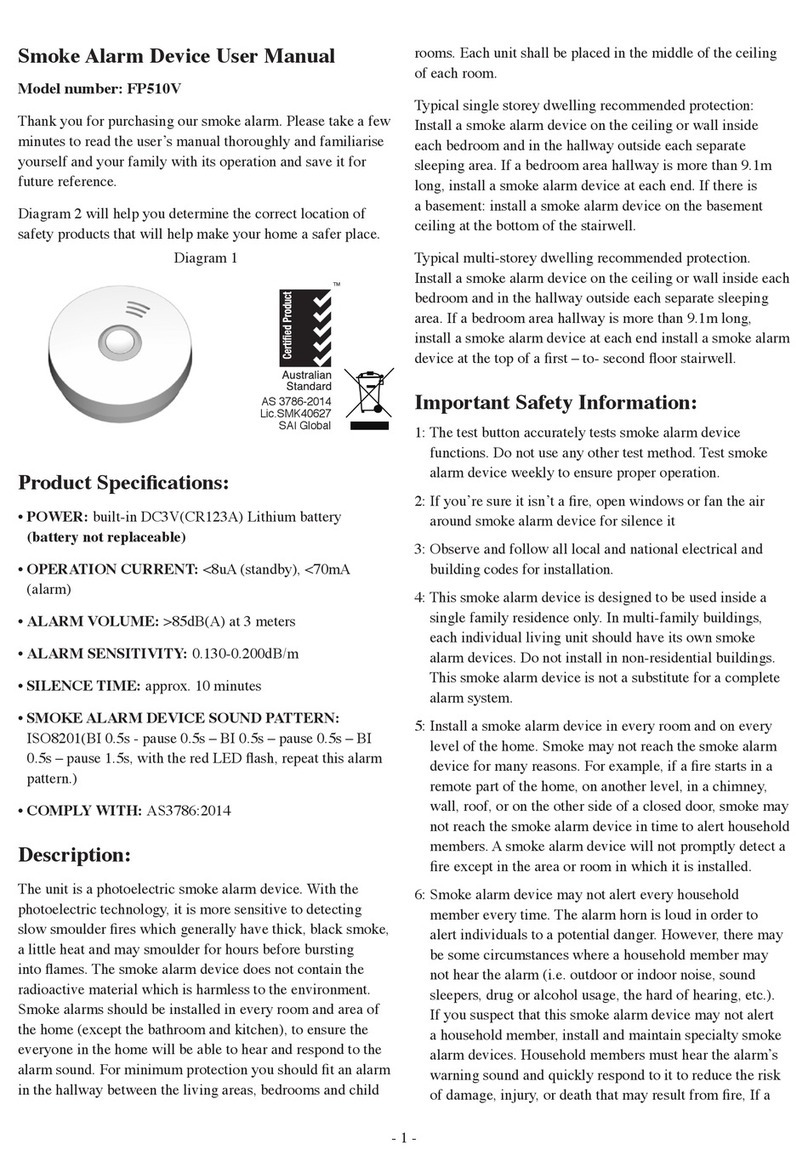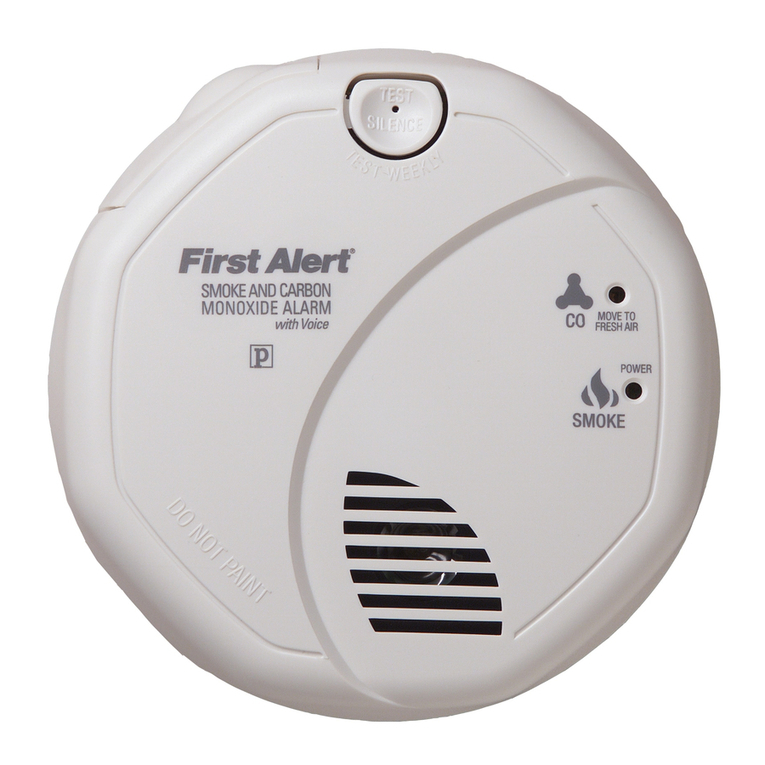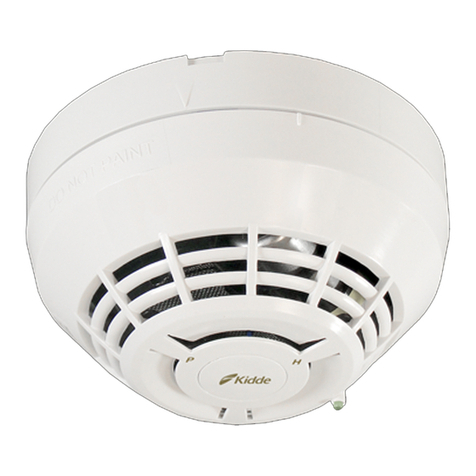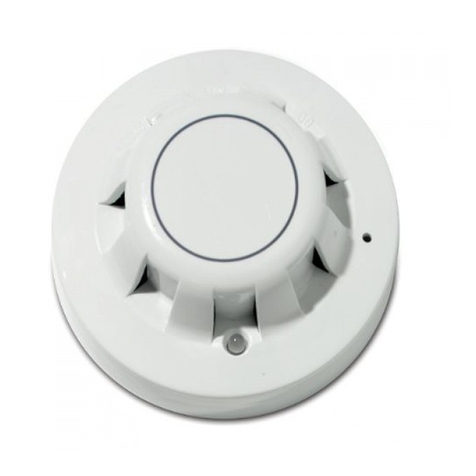Fire Pro FP510V User manual

B:noisreV
- 1 -
Smoke Alarm Device User Manual
Model number: FP510V Ref:ST508E
Thank youforpurchasing our smoke alarm device. Please take
afew minutes to read the user’s manual thoroughly and
familiarize yourself and your family with its operation. And
save it for future reference.
Diagram2 will help you determine the correct location of safety
productsthat will help make your home a safer place.
Diagram 1
Product Specifications:
POWER: built-in DC3V(CR123A) Lithium battery
(battery not replaceable)
OPERATION CURRENT:<8uA (standby), <70mA
(alarm)
ALARM VOLUME: >85dB(A) at 3 meters
ALARM SENSITIVITY: 0.130-0.200dB/m
SILENCE TIME: approx. 10 minutes
SMOKE ALARM DEVICE SOUND PATTERN:
ISO8201(BI 0.5s - pause 0.5s – BI 0.5s – pause 0.5s – BI
0.5s – pause 1.5s, with the red LED flash, repeat this alarm
pattern.)
COMPLY WITH: AS3786:2014
Description:
The unit is a photoelectric smoke alarm device. With the
photoelectric technology, it is more sensitive to detecting slow
smolder fires which general thick, black smoke, a little heat and
may smolder for hours before bursting into flames. The smoke
alarm device does not contain the radioactive material which is
harmless to the environment.
The smoke alarm device should be installed in everyroom
(except the bathroom and kitchen), and everyother area of the
home, making sure the people in the home will be able to hear
andrespond to the alarmsound. For minimum protection, you
should fit an alarm respectively for the hallways, living room,
bedrooms and child rooms, each unit shall be placed in the
middle of the ceiling of eachroomto protect.
Typical single storey dwelling with recommended:
Install a smoke alarm device on the ceiling or wall inside each
bedroom and in the hallway outside each separate sleeping area.
If a bedroom area hallway is more than 30 feet long, install a
smoke alarm device at each end. If there is a basement: install a
smoke alarm device on the basement ceiling at the bottom of
the stairwell.
Typical multi-storeydwelling with recommended protection.
Install a smoke alarm device on the ceiling or wall inside each
bedroom and in the hallway outside each separate sleeping area.
If a bedroom area hallway is more than 30 feet long, install a
smoke alarm device at each end install a smoke alarm device at
the top of a first – to- second floor stairwell.
Important Safety Information:
1: The test button accurately tests smoke alarm device functions.
Do not use any other test method. Test smoke alarm device
weekly to ensure proper operation.
2: If you're sure it isn't a reallyalarm, open windows or fan the
air around smokealarmdevice for silence it
3: Observe and follow all local and national electrical and
building codes for installation.
4: This smoke alarm device is designed to be used inside a
single family only. In multifamily buildings, each individual
living unit should have its own smoke alarm devices. Do
not install in non-residential buildings. And this smoke
alarmdevice is not a substitute for a completealarmsystem.
5: Install a smoke alarm device in every room and on every
level of the home. Smoke may not reach the smoke alarm
device for many reasons. For example, if a fire starts in a
remote part of the home, on another level, in a chimney,
wall, roof, or on the other side of a closed door, smoke may
not reach the smoke alarm device in time to alert household
members. A smoke alarm device will not promptly detect a
fire except in the area or room in which it is installed.
6: Smoke alarm device may not alert every household member
every time. The alarm horn is loud in order to alert
individuals to a potential danger. However, there may be
some circumstances where a household member may not
hear the alarm (i.e. outdoor or indoor noise, sound sleepers,
drug or alcohol usage, the hard of hearing, etc.). If you
suspect that this smoke alarm device may not alert a
household member, install and maintain specialty smoke
alarm devices. Household member must hear the alarm’s
warning sound and quickly respond to it to reduce the risk
of damage, injury, or death that may result from fire, If a
household member is hard of hearing, install specialsmoke
AS 3786:2014
Lic.SMK40627
SAI Global

Version:B
- 2 -
alarm devices with lights or vibrating devices to alert
occupants.
7: Smoke alarm devices can only sound their alarms when they
detect smoke or detect combustion particles in the air. They
do not sense heat, flame, or gas. This smoke alarm device is
designed to give audible warning of a developing fire.
However, many fires are fast - burning, explosive, or
intentional, and others are caused by carelessness or safety
hazards. In this circs, Smoke may not remake the unit alarm
QUICKLY ENOUGH to ensure safe escape.
8: Smoke alarm devices have limitations. This smoke alarm
device is not foolproof and is not warranted to protect lives
or property from fire. Smoke alarm devices are not a
substitute for insurance. Homeowners and renters should
insure their lives and property. In addition, it is possible for
the smoke alarm device to fail at any time. For this reason,
you must test the smoke alarm device weekly and replace
unit every 10 years.
Do Not Install Smoke alarm devices in
the Following Places:
1: Near appliances or areas where normal combustion
Regularly occurs (kitchens, near furnaces, hot water heaters).
Use specialized smoke alarm device with unwanted alarm
control for this areas.
2: In areas with high humidity, like bathrooms or areas near
dishwashers or washing machines. Install al least 10feet
away from these areas.
3: Near air returns or heating and cooling supply vents. Install
at least 3 feet away from these areas. The air could blow
smoke away from the detector, interrupting its alarm.
4: In rooms where temperatures may fall below 5℃or rise
above 45℃,or in humidity higher than 85%. These
conditions will reduce battery life or cause a fault alarm.
5: In extremely dusty, dirty, or insect – infested areas influence
particles interfere with smoke alarm device operation.
Operation:
Testing
Test the unit to ensure proper operation by pressing the test
button, this will sound the alarm if the electronic circuitry,
horn, and battery are working. If no alarm sounds, there is a
defective battery or other failures, you can refer to “Trouble
shooting” section for solution.
DO NOT use an open flame to test your alarm, you could
damage the alarm or ignite combustible materials and start a
fire.
CAUTION: Due to the loudness (85 decibels) of the alarm,
Always stand an arms-length away from the unit when testing.
Test the alarm weekly to ensure proper operation. Erratic or low
sound coming from your alarm may indicate a defective alarm,
you can refer to “Trouble shooting” section for solution.
NOTE: WEEKLYTESTING IS REQUIRED.
LED indicators
Red LED-Flashing once every 40 seconds: indicates that the
smoke alarm device is operating properly.
Red LED-Flashing when the test button is pressed, or when
the smoke alarm device senses particles of combustion and goes
into alarm (constant pulsating sound), the red LED will flash
once per second. The flashing LED and pulsating alarm will
continue until the air is cleared or release test button.
Red LED-Alarm silencer (Hush mode) indication: The red
LED will flash once every 8 seconds, indicating the smoke
alarm device is in the alarm silence (Hush) mode.
Low battery indication - An intermittent “chirp” with red LED
flashes once every 40 seconds: indicates that the smoke alarm
device is low battery, you may press the test button for pause
alarm for 10 hours, but it will reset automatically after 10 hours.
Fault indication - The alarm chirp occurs every 40 seconds.
NOTE:When the units chirp once every 40 seconds, you can
press the test button temporarily for pausing this warning tone
for 10 hours,it can still normally detect smoke during this
period, it only removes nuisance warning tone. You can refer to
“Trouble shooting” for solution, if there are still failures, you
MUST replace it with a new alarm at once or contact you
retailer during warranty.
Alarm silence (silence mode)
During the unit is alarming, you push the test button, it will be
paused the unit alarming for approx 10 minutes. The red LED
will flash once every 8seconds, it indicates the smoke alarm
device is running into the silence mode. Smoke alarm devices
are designed to minimize nuisance alarms. Combustion
particles from cooking may set off the alarm if the alarm is
located close to the cooking area. Large quantities of
combustible particles are generated from spills or when
grilling/frying. Using the fan on a range hood that vents to
outside (non-recirculating type) will also help remove these
combustible particles from the kitchen. The alarm silence (test
button) is extremely useful in a kitchen area or other areas
prone to nuisance alarms. The silence feature is to be used only
when a known alarm condition, such as smoke from cooking
activates the alarm.
The smoke alarm device is desensitised by push the alarm
Silence (silence mode) on the smoke alarm device cover, the

Version:B
- 3 -
alarm will silence to indicate that the alarm is in a temporarily
desensitised condition.
The smoke alarm device will automatically reset after
approximately 10 minutes, if after this period, particles of
combustion are still present, the alarm will sound again.
The alarm silencer (silence mode) can be repeatedly until the air
has been cleared of the condition causing the alarm.
CAUTION: Before using the alarm silence,identify the
source of the smoke and be certain a safe condition exists.
NOTE: Dense smoke will override the alarm silencer and will
sound a continuous alarm again.
DANGER: If the alarm sounds, and it is not being tested, it
means the unit is sensing smoke, THE SOUND OF THE ALARM
REQUIRES YOUR IMMEDIATE ATTENTION AND ACTION.
Maintenance and Cleaning:
The alarm should be cleaned at least once a year
·To clean your alarm, remove it from bracket on ceiling, you
can clean it by using compressed air or a vacuum cleaner
hose with a soft brush attachment. Blow or vacuum around
the perimeter of the alarm to remove dust and dirt and debris.
The outside of the alarm can be wiped with a damp cloth but
you use a wet cloth in order to avoid water entering the inner
of alarm.
·After cleaning , reinstall it and test it by pressing the Test
button. The alarm should be replaced if cleaning can’t restore
the alarm to normal operation.
·This alarm has a low battery monitor which will cause the
alarm to “chirp” approx every 40 seconds and the red LED
flash once at the same time for a minimum of thirty days
when the battery gets low.
If there is a defective battery or other failures, you can refer
to “Trouble shooting” for solution, or deactivate this alarm to
stop nuisance alarm which is caused by a failure of their
function. If there are still failures during warranty, you can
return to your retailer.
Don’t paint the unit. Paint will seal the vents and interfere
with the sensor’s ability to detect smoke.
NOTE: 1.REGULAR WEEKLYTESTING IS REQUIRED!
2.Must reactivate alarm before use if you deactivate it.
Replacing the Alarm
It is recommended this alarm should be replaced ten years from
the date of manufacture. This date has been provided on the
product label which is located on the back of the alarm.
WARNING: The battery is sealed in cover and not
replaceable. Please replace another new alarm if the low
battery chirp occurs.
IMPORTANT: Do not attempt to remove the cover to clean
inside. This will affect warranty.
Repair:
If the alarm is not operating properly, and is still under
warranty, return it to the original place you buy. Pack it in a
well-padded carton, and ship to the original place you buy.
If the alarm is no longer under warranty, please replace it
immediately with a comparable alarm.
Caution: Do not attempt to repair the alarm. It will affect
your warranty.
Trouble shooting:
Problem Trouble shooting
Smoke alarm device
does not sound when
tested.
1. Must activate alarm before
installation.
2. Clean smoke alarm device.
Please refer to the
“maintenance and cleaning”
section.
3. if there are still failures during
warranty, you can return to
your retailer.
4. if the unit is out of warranty,
please replace another new alarm.
The alarm “chirp” with
red LED flashes once
every 40 seconds.
The battery is under low battery
status,please replace the smoke
alarm device.
Smoke alarm device
chirp occurs every
40 seconds(alarm goes
into fault mode).
Clean smoke alarm device. Please
refer to the “maintenance and
cleaning” section. Purchase and
change another smoke alarm device
if the problem still exist
Smoke alarm device
sounds, unwanted
alarms intermittently or
when residents are
cooking, taking
showers, etc.
1. Press test button to pause alarm.
2. Clean smoke alarm device.
Please refer to the “maintenance
and cleaning” section.
3. Move smoke alarm device to new
location and press test button.
The alarm sounds
different from it is used
to. It starts and stops.
1. Clean smoke alarm device.
Please refer to the “maintenance
and cleaning” section.
2. if there are still failures during
warranty, you can return to your
retailer.
3. if the unit is out of warranty,
please replace another new alarm.

B:noisreV
- 4 -
How to deactivate the smoke alarm:
Press test button and hold it for above 10 seconds until LED
flashes rapidly (flash 5 times per second), then press Test button
rapidly for at least 6 times within 5 seconds (or within during
LED flashes rapidly), and the unit will generate a “beep”
indicates the production goes into inactivation status There will
be no any functions at this status, you must reactive it before
use, Please refer to the chapter "installation" for activating the
product
Note: Deactivate this alarm if you need disposal it or stopping
nuisance alarm which is caused by a failure of their function
Practice Fire Safety:
If the alarm sounds, and you have not pushed the test button,
it is warning of a dangerous situation, your immediate response
is necessary. To prepare for such occurrences, develop family
escape plans, discuss them with all household
members, and practice them regularly.
1: Expose everyone to the sound of a smoke alarm device and
explain what the sound means.
2: Determine two exits from each room and an escape route to
the outside fromeach exit.
3: Teach all household members to touch the door and use an
alternate exit when the door is hot, instruct them not to open
the door if the door is hot.
4: Teach household members to crawl along thefloor to stay
below dangerous smoke, fumes and gases.
5: Determine a safe meeting place for all members outside the
building.
What to Do in Case of Fire:
1: Do not be panic; stay calm.
2: Leave the building as quicklyas possible. Touch doors to feel
if they were hot before opening them. Use an alternate exit if
necessary. Crawl along the floor, and do stop to collect
anything.
3: Meet at a pre-arranged meeting place outside the building.
4: Call the firedepartment form outside the building.
5: Do not go back inside a burning building. Wait for the fire
department to arrive.
Note: These guidelines will assist you in the event of a fire,
however to reduce the chance that fires will start, practice fire
safetyrulesand prevent hazardous situations.
TOTAL HOME PROTECTION
Diagram 2
Warranty Information:
Company warrants to theoriginal consumer.
Purchase each new smoke alarm device to be free from defects
in material and workmanship under normal use and service for
a period of 10 years from the date of purchase. This warranty
does not coverdamage resulting from accident, misuse or abuse
or lack of reasonable care oftheproduct.
In nocase shall companybeliable for any incidental or
consequential damages for breach of this or any other warranty
express or implied,whatsoever. The bad product can be mailed
to thefollowing address with a detail explanation of problem.
Where is the best to be Installed:
·Install the first alarmin the immediate area of the bedrooms.
Install additional alarms to monitor theexit path, as the
bedrooms are usuallyfarthest from the exit. If more than one
sleeping area exists, locate additional alarms in each sleeping
are (see Diagram 3).
·Install additional alarms to monitor any stairway as stairways
act like chimneys for smoke and heat.
·Install at least one alarm on every floor level ( see Diagram 4)
·Install an alarm in every bedroom.
·Install an alarm in every room where large electrical
appliances are operated (for example portable heaters ).
·Installan alarmin every roomwhere someone sleeps with the
door closed. The closed door may prevent an alarm located
outside from waking the sleeper.
·Smoke, heat, and combustion products rise to the ceiling and
spread horizontally. Mounting the smoke alarm on the ceiling
in the centre of the room places it closest to all points in the
room. Ceiling mounting is preferred in ordinary residential
construction.

Version:B
- 5 -
·When mounting an alarm on the ceiling, locate it at a minimum
of 30 cm (12 in) from the side wall (see Diagram 5).
·Put smoke alarm at both ends of a bedroom hallway or large
room if the hallway or room is more than 9.1 m (30 ft) long.
·Install smoke alarms no slopped, peaked or cathedral ceilings
between 500 and 1500mm from the highest point of the
ceiling. Smoke alarms in rooms with ceiling slopes greater
than 1m in 8 m horizontally shall be located on the high side
of the room (See Diagram 6)
Diagram 3
Diagram 4
Side wall
Diagram5
Smoke alarm should be located between
500 and 1500mm from the highest point.
Diagram 6

B:noisreV
- 6 -
Installation:
Activation
Press test button and hold it for above 3 seconds until
LED lights, and release it within 2 seconds, the unit will
generate a “beep” indicates that it is activated and goes
into work status
CAUTION: MUSTactivate alarm first, or else there is no
function for this unit.
·Turn the alarm body counterclockwise and take off the
bracket.
·Press the bracket on the installation position, mark
installation hole of the bracket with pencil.
·Bore two installation holes on the sign with electric drill.
Make diameter of holes is 5mm, Strike the two plastic plugs
into holes with hammer.
·Remove fixing plug from the bracket with screwdriver if
necessary (See Diagram 7).
·Attach the bracket to the plastic plugs and fix tightly the
screws into the plastic plugs(See Diagram8).
·Fit the alarm on the bracket and turn the alarm body
clockwise, until matching well on the bracket.
·Insert fixing plug to the gap between bracket and bottom
cover for fixing alarm if you want ( See Diagram 9).
·Press the button for test the unit. The alarm sounds 3 beeps –
1.5 seconds pause, repeat it until release the button, if no
sound, it indicates a defective alarm, you can refer
to ”Trouble shooting” for solution or return to your retailer
during warranty.
·If you have any questions on installation, you can contact
your retailer.
WARNING:
To prevent injury, this unit must be securely attached to the wall
or ceiling in accordance with the installation instructions.
Diagram 7
Diagram 8
Diagram 9
FirePro
138–140 Bayfield Rd East,
Bayswater North, VIC, 3153. Australia.
P (03) 9720 4333
F (03) 9720 4344
MODEL NUMBER: FP510V
Table of contents
Other Fire Pro Smoke Alarm manuals
Popular Smoke Alarm manuals by other brands
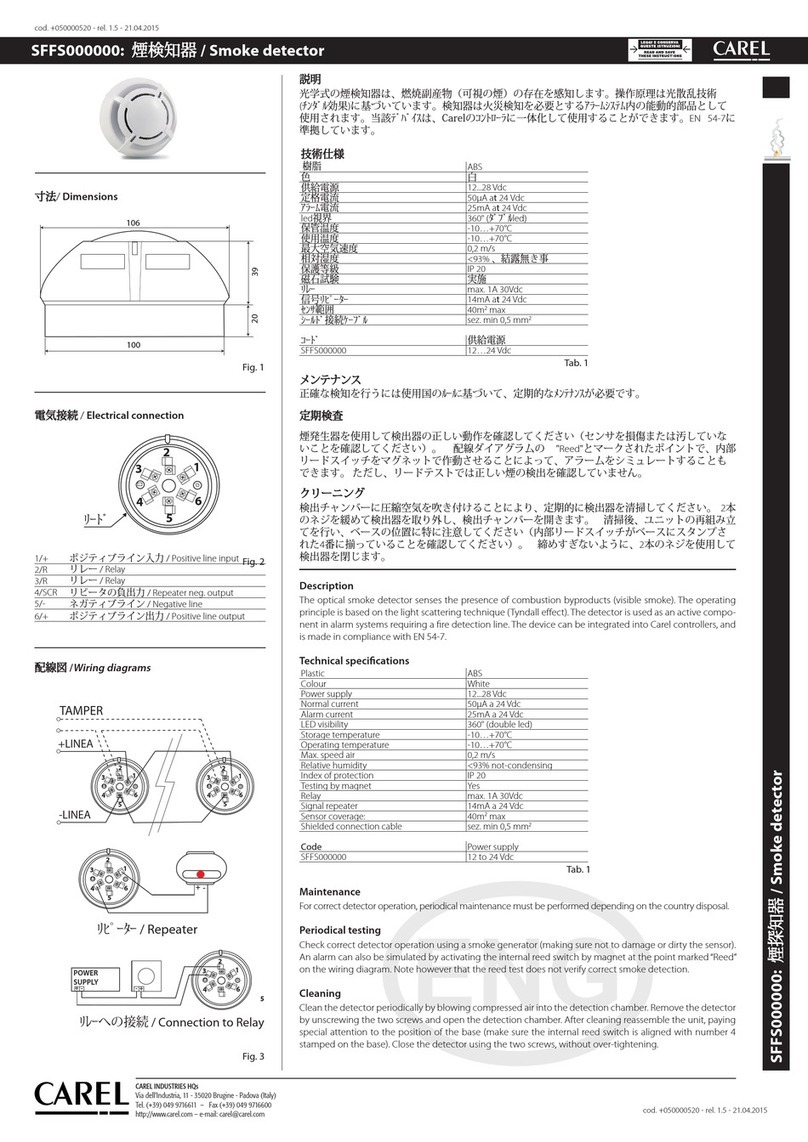
Carel
Carel SFFS000000 quick start guide
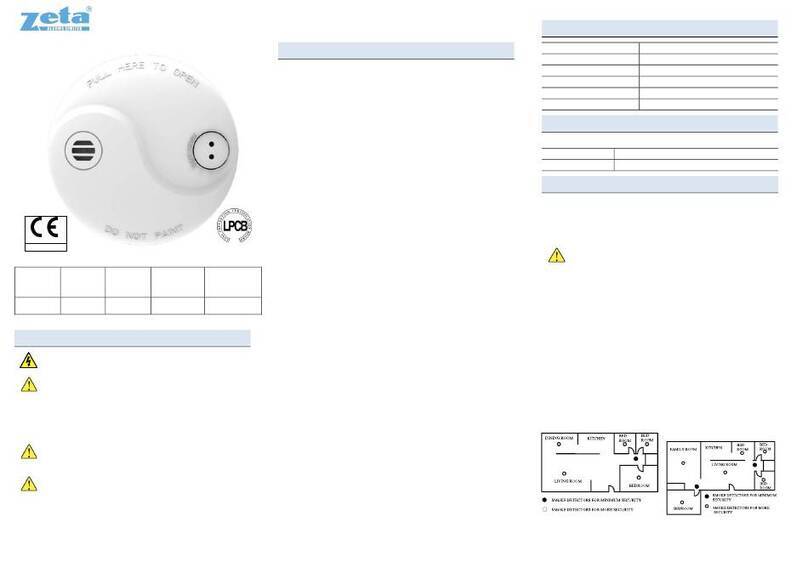
Zeta
Zeta ZT-MS user manual
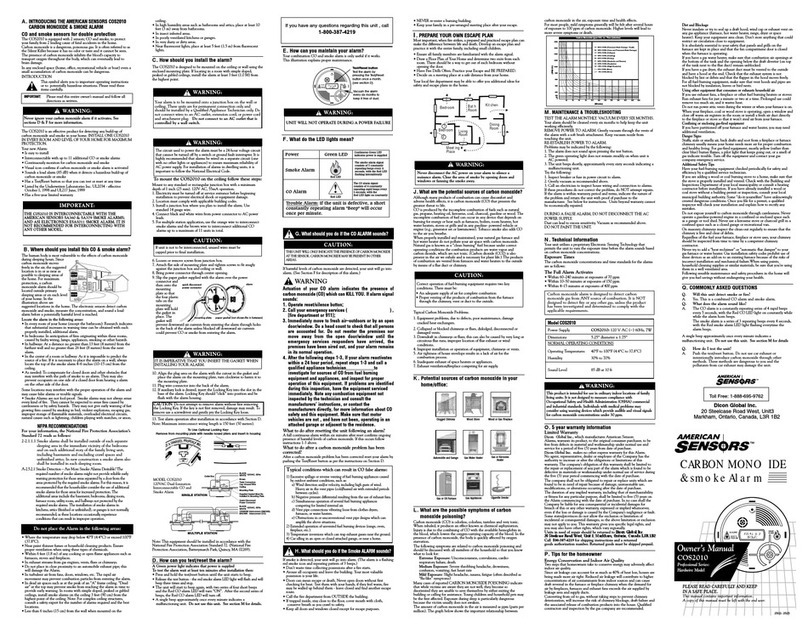
American Sensor
American Sensor Professional COS2010 owner's manual
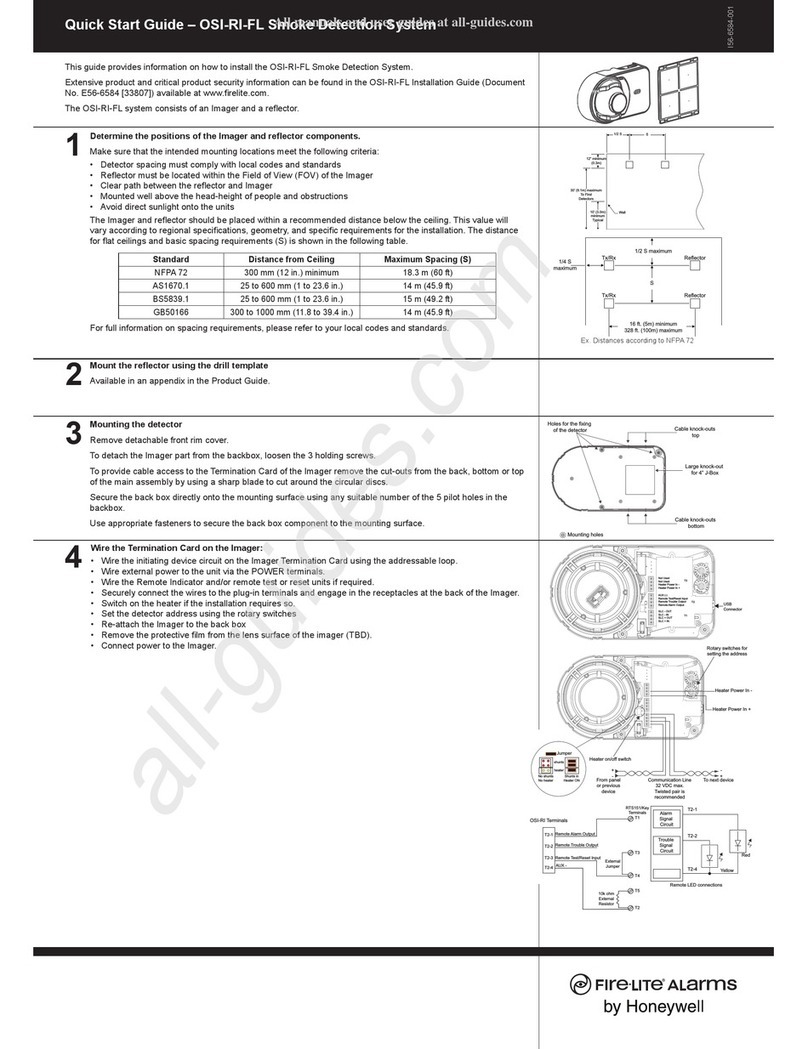
Honeywell
Honeywell Fire-Lite Alarms OSI-RI-FL quick start guide
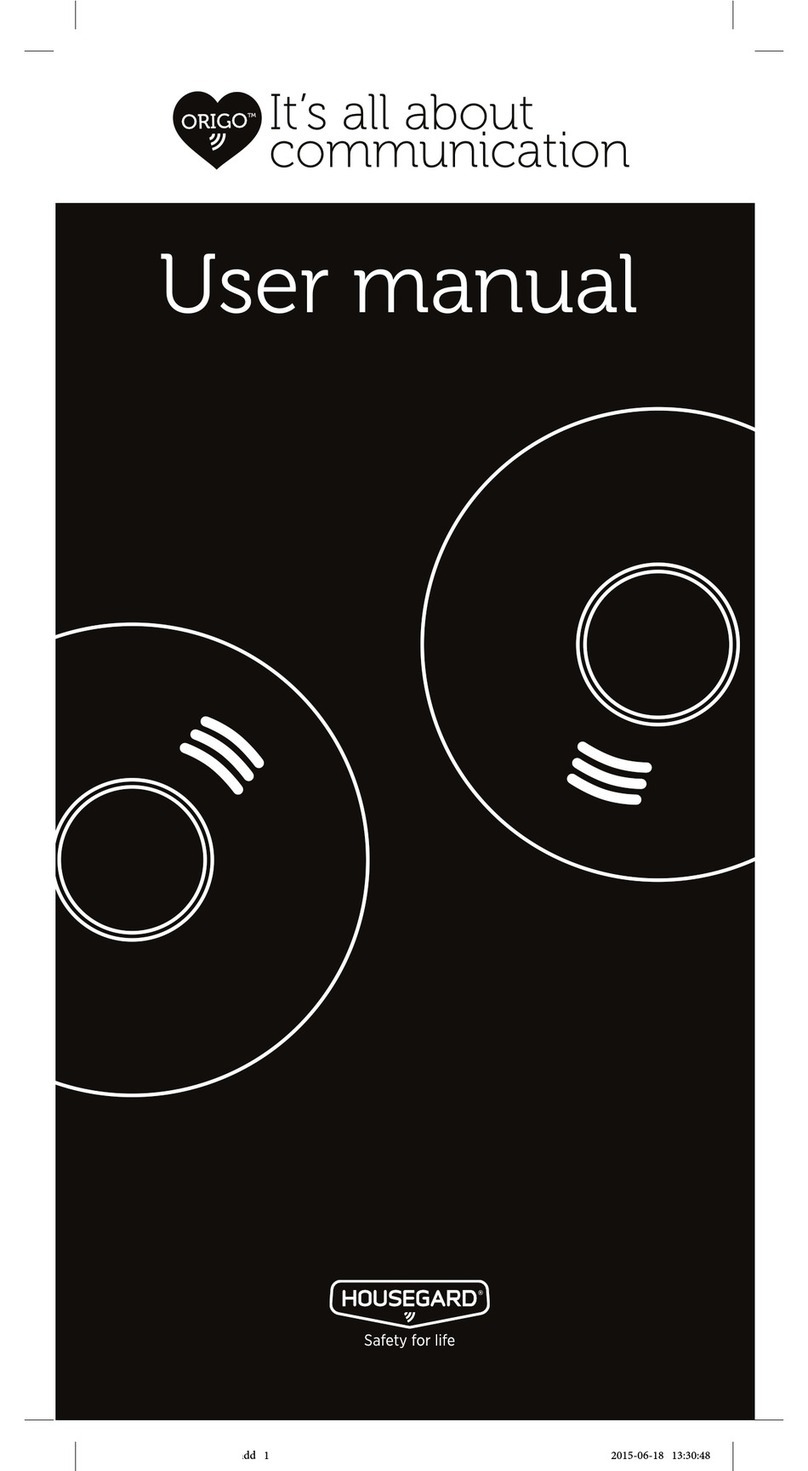
ORIGO
ORIGO SA422WS user manual

Teletek electronics
Teletek electronics SensoIRIS MCP150 installation instructions
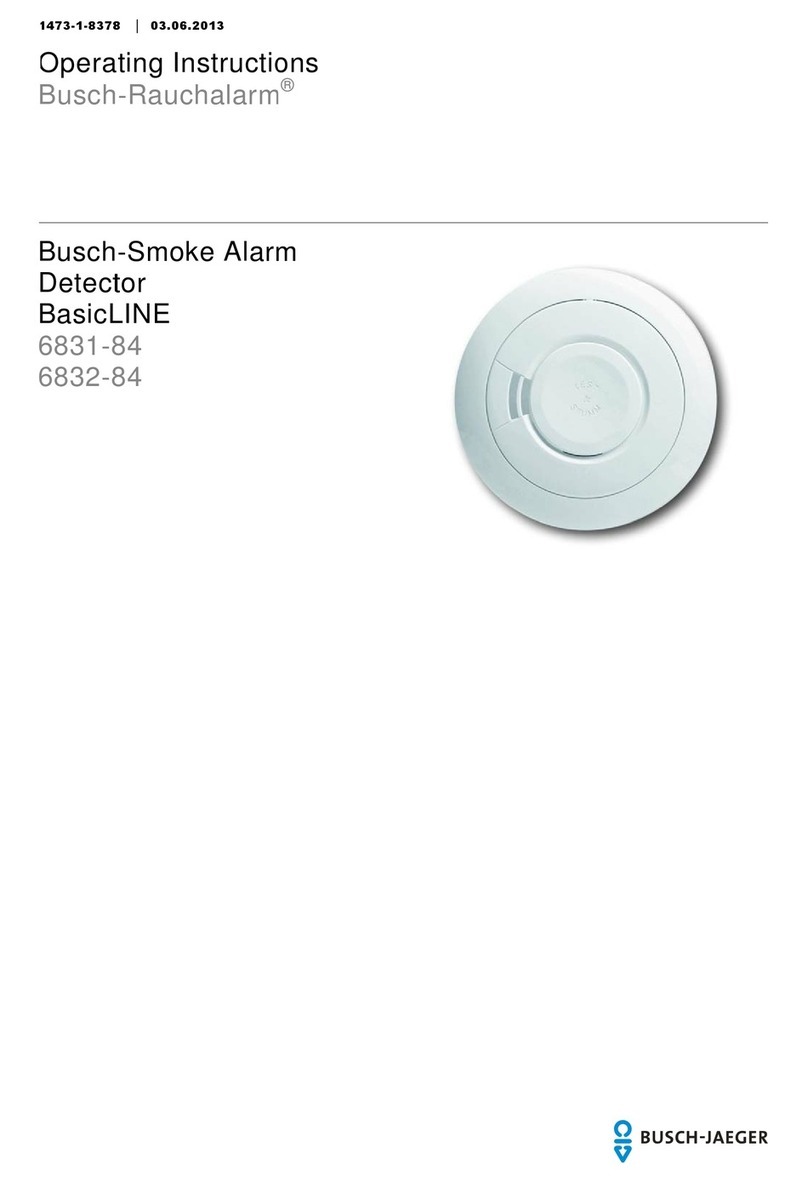
Busch-Jaeger
Busch-Jaeger BasicLINE 6831-84 operating instructions
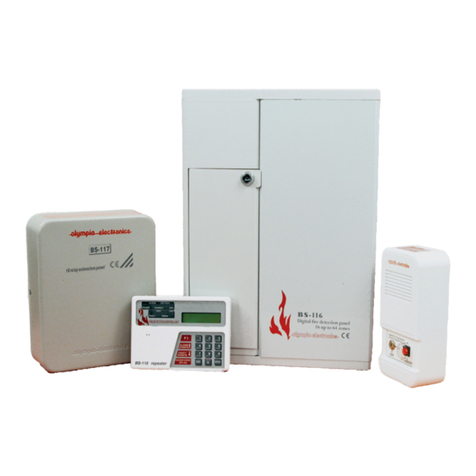
olympia electronics
olympia electronics BS-116 Operation manual
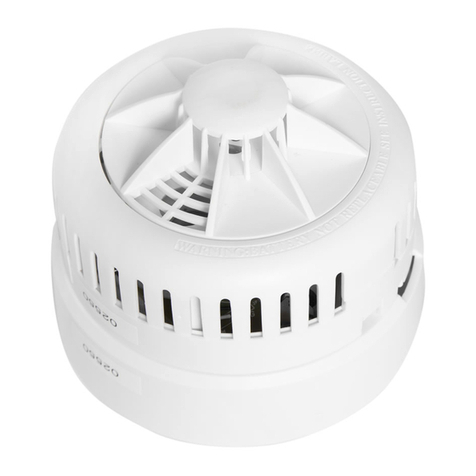
Firehawk
Firehawk FHH10W user manual

Spectrex
Spectrex SafEye 200 Series User and maintenance manual
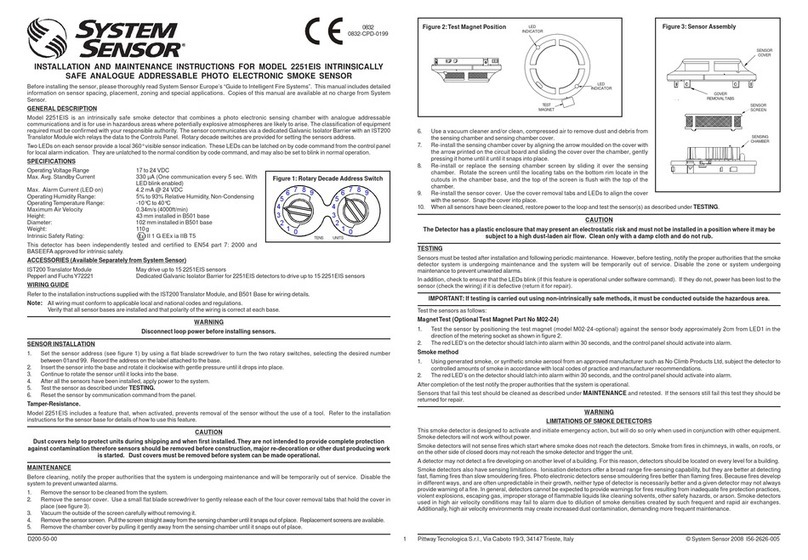
System Sensor
System Sensor 2251EIS Installation and maintenance instructions
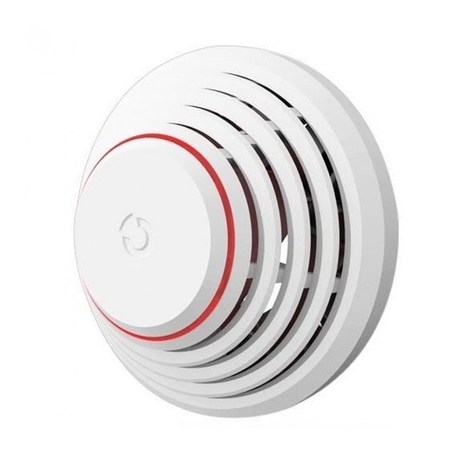
jablotron
jablotron SD-283ST quick start guide


